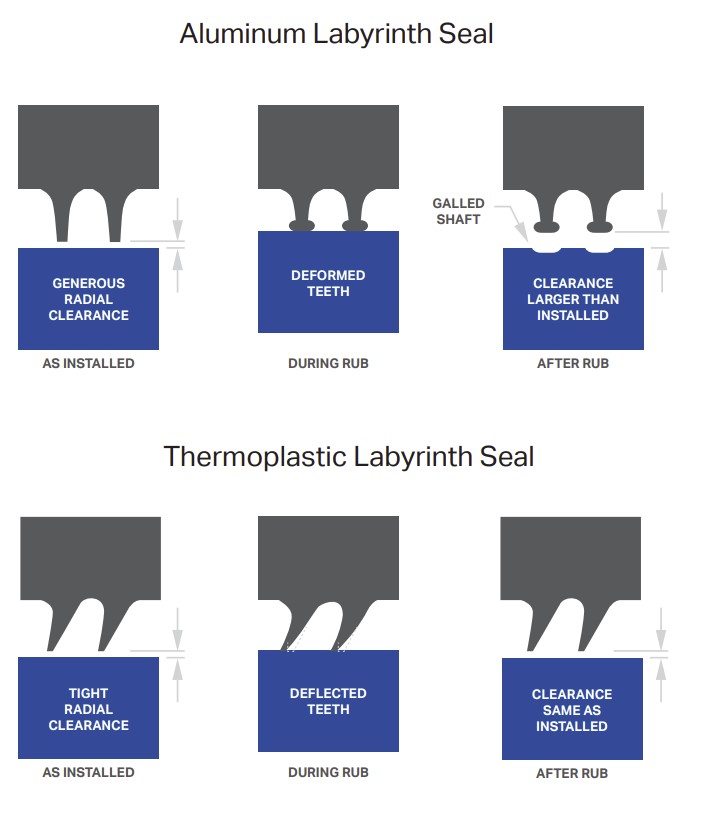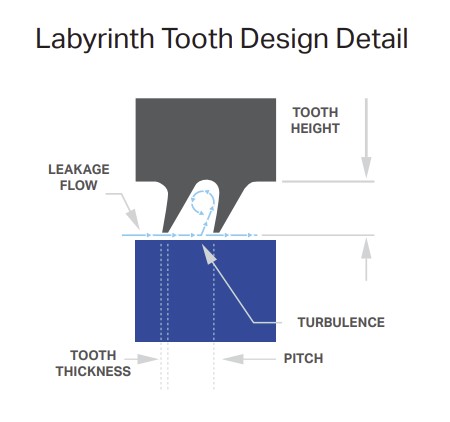
THERMOPLASTIC LABYRINTH SEALS
Applying Thermoplastic Labyrinth Seals
Centrifugal compressors use labyrinth seals at the impeller eyes, between impellers, and at the balance drum. The purpose of the labyrinth seals is to reduce flow between stages; therefore, tight clearance and minimum flow between stages is an important factor in centrifugal compressor efficiency.
If you have a centrifugal compressor that was originally designed with stationary aluminum labyrinth seals, Boulden’s team at GCBS (Gulf Coast Bearing & Seal) can help. They have worked with OEMs, repair shops, and end users to upgrade hundreds of compressors from aluminum labyrinth seals to thermoplastic labyrinth seals. This simple change allows tighter clearance at the labyrinth seals, which will help increase your compressor efficiency and throughput.
Key benefits of thermoplastic labyrinth seals:
- Non-seizing, non-galling material allows tighter running clearance
- Increased compressor flow rate
- Increased compressor efficiency
- Tolerant of transient contact at start-up
- Improved chemical resistance over aluminum
- Lower wear and longer life
Syngas plants can upgrade their syngas, ammonia, and air compressors. Ethylene crackers can upgrade their ethylene refrigeration, propylene refrigeration, and charge gas trains. Refineries can look at their wet gas, hydrogen recycle, and air compressors. Gas plants can consider any of their hydrocarbon compressors. If your centrifugal compressors are still using stationary aluminum labyrinth seals, contact Boulden today.

Background
Many compressors are designed with stationary aluminum labyrinth seals. While aluminum can be a good low-cost, first-fit solution during the construction project, there are drawbacks for the end user. To avoid hard contact between the aluminum labyrinth seals and the compressor rotor, aluminum seals require generous radial clearance. Even so, contact can occur as the machine passes through a critical speed or during a momentary surge, which can result in damage to the tips of the aluminum labyrinth seals and potential damage the rotor. Any damage will further increase the clearance at the labyrinth seals. The larger clearances used with aluminum labyrinth seals represents a loss of compressor efficiency as gas “leaks” across stages within the machine. This internal leakage also limits the maximum throughput of the compressor.
Compressor owners can improve efficiency with a simple upgrade to thermoplastic labyrinth seals. Engineered thermoplastics allow reduced clearances because they are non-galling and non-seizing. GCBS uses an engineered, angled tooth profile so that the teeth can flex and return to their original position after transient contact. Due to the careful material selection and design of these seals, damage to the seals and rotor is avoided during transient rubs, resulting in minimum clearance and improved efficiency throughout the full turnaround cycle of the compressor. Thermoplastic labyrinths are also generally easier to install and remove compared to aluminum and can eliminate corrosion problems experienced by aluminum in some services.
The improved performance associated with thermoplastic labyrinth seals will typically be evident as improved efficiency or increased throughput. One typical rule of thumb used for justification purposes is to assume ½% efficiency gain per impeller. If increased throughput is possible, field experience suggests ½ to 1% increased flow per impeller. For example, if you have a compressor with six impellers, you can estimate a 3% efficiency gain or an increase in flow of 3-6% to justify the upgrade to thermoplastic laby seals. Using either assumption should produce an extremely attractive return on investment for the upgrade.

The Process
Our team at GCBS has upgraded the laby seals in hundreds of compressors over the past 30 years. We have upgraded the labyrinth seals in compressors from the major compressor OEMs and are a certified vendor for many of them. OEMs, repair shops, and end users rely on GCBS for this upgrade due to our thorough engineering and manufacturing excellence.
The process starts with a drawing of the existing labyrinth seals to ensure proper fit at installation, but we go far beyond replicating the existing part. The compressor rotor diameters are used as a reference. GCBS then engineers each labyrinth seal for minimum clearance. We run a thermal growth calculation for each labyrinth seal based on operating temperature per stage. We also consider the rotating speed of the compressor, the type of compressor, and the bearing clearance. GCBS uses an optimized raked tooth profile which both minimizes flow between stages and allows the teeth to flex and return to position during transient contact.

Our material selection is based on decades of experience. Most seals will be manufactured with either Torlon® or PEEK® composite materials. Torlon® labyrinth seals have higher temperature capabilities. PEEK® labyrinth seals have advantages when certain chemicals are present. The final material selection will be made based on your process gas, operating temperature, and any auxiliary processes—such as caustic wash—which need to be accounted for. Our team understands the processes involved and can advise you on the best material for your service.
Finally, the team at GCBS will analyze the design of the labyrinth seal to ensure it is strong and secure. Some geometries require installing the thermoplastic seal inside a metal support ring. Radially split compressors have different designs from axially split compressors. We will make sure that the thermoplastic labyrinths are properly designed for the specific geometry of your compressor to provide years of reliable service.

Manufacturing Excellence
Once the material selection and design are complete, we manufacture the parts at the GCBS world class facility in Houston. We use modern CNC machines to produce parts with exceptional accuracy and precision. We can produce labyrinth seals up to 40” (1000 mm) diameter.

Our team takes care of the details to make sure your labyrinth seals are optimized. We us special diamond tooling to ensure an optimal surface finish. To make axially split parts, we split the material, clamp the halves together, then machine the labyrinths. This creates a part with no end gap or leakage path along the split line.
Whatever your plant operation or service, if you have a centrifugal compressor with stationary aluminum labyrinth seals, contact Boulden. We can evaluate the service conditions and labyrinth seal design to recommend an ideal upgrade for your next turnaround.